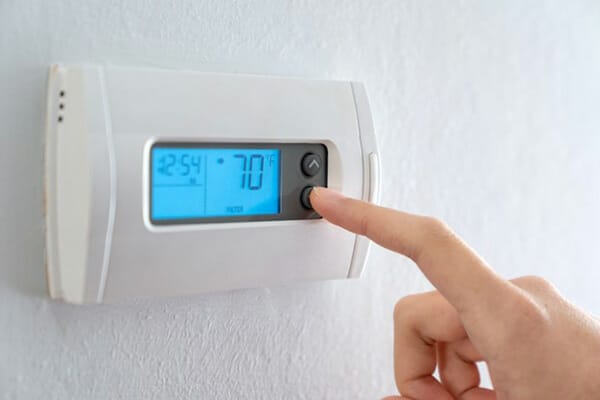Homeowners pay a pretty penny for heating and cooling costs to keep their homes chilled during hot summers and warm and cozy during chilly winters. This is especially true in places like Texas where extreme weather is becoming more common. Unfortunately, leaky and drafty windows and doors can let unfavorable air into your home, causing your energy bills to rise.
Fortunately, you can seal air leaks around windows and doors with weatherstripping and caulking to stop these leaks and prevent this unwanted airflow into your home. Get the details on this cost-effective process and how to successfully seal your windows and doors from air leakage.
How Do You Seal Air Leaks Around Doors and Windows?
When you have an air leak around doors and windows or want to prevent them, you have several options to seal it. Generally, you’ll use caulking, silicone, or weatherstripping. The right option depends on where the leak is located and whether it’s coming from a moving or fixed part of the door or window.
What Is the Best Way to Seal Against Air Leaks on Doors?
You have several options to seal your doors against energy-robbing air leaks. Your choice depends on what part of the door you’re sealing. Weatherproof caulking or silicone is your best bet if you’re sealing a fixed part of the door assembly, such as the frame surrounding the door.
However, new weatherstripping is best for long-term durability if you’re sealing a moving part, such as where the door rests against the door frame when closed.
How Do You Seal Air from Coming Through Windows?
Window sealing follows the same process as sealing doors. If you’re sealing a fixed part of the window (like around the frame), weatherproof caulking or silicone is your best bet. However, in moving areas, such as where the window meets the frame or where the two panes of glass meet, new weatherstripping is the more reliable option.
Why Should You Seal Air Leaks Around Windows and Doors with Weatherstripping and Caulking?
Heating and cooling are the largest energy consumers in the typical household, and leaky windows alone account for about 30% of this energy loss for homeowners. A portion of this could simply be outdated windows, but it can also be air leaks allowing cold air in during the winter and hot air in during the summer. This forces your heating, ventilation, and air conditioning (HVAC) system to work harder to maintain a comfortable temperature.
When you seal air leaks around windows and doors with weatherstripping and caulking, you help reduce the amount of work your HVAC system must do, reducing energy costs.
Pro tip: If you have the budget, invest in energy-efficient windows to save energy and money in the long run.
Can Silicone Stop Air Leaks? 
Yes, silicone caulk can effectively keep the outside air out of your home and increase its overall energy efficiency in the hot summers and cold winters. Use weatherproof caulking, though, as it remains flexible and intact during hot and cold spells.
Want to try something other than silicone caulk? You can also opt for low-expansion spray foam. This is especially effective if you have a larger leak that silicone cannot expand to fill. This spray foam will expand enough to fill that gap without looking sloppy.
Updating leaks is just one of the many energy-efficient home improvements for seasonal savings.
What Is the Air Leak Around Windows and Doors Called?
While air leaks around doors and windows generally fall under the generic term “draft,” one type of leak has a specific name. This type of leak comes from around the window or door frame inside the house. Experts refer to this leak as a cavity leak, as the air gets inside the cavity of your walls and then seeps out through gaps in the door or window frame and other areas, like electrical wall plates.
Enter your ZIP Code and compare electricity rates
How Do You Seal a Door and Window Gap?
You can seal door and window gaps with caulking, low-expansion foam, or weatherstrips, depending on the area you’re working on and the gap size. If it’s a fixed area with a small gap — a quarter-inch wide or narrower — use caulk. If it’s a fixed area with a crack wider than a quarter inch, opt for low-expansion foam or place a foam backer beam into the hole before caulking. Use weatherstripping if you’re working on a moving area, such as where the door or window meets the frame.
Here’s how to perform each task.
How to Caulk Around a Door and Window
Always start with a fresh, clean surface. Remove any old caulk from the window or door frame using a scraper. Leaving behind old caulk can lead to the new caulk peeling off more quickly.
Here’s a step-by-step on the rest of the process:
- Place the caulk in a high-quality caulk gun with a thumb release — inexpensive caulk guns often have a twist-release mechanism that can lead to inconsistent caulk lines.
- Prepare the caulk tube by cutting off the very end of its tip, leaving only a small opening.
- Run a test caulk bead to see if the hole is large enough to allow the caulk to fill the gap. If not, cut more off the tip.
- Continue this process until the caulk bead is wide enough to fill the gap without leaving behind too much excess caulk. If the crack is wider than a quarter inch, cut a piece of foam backer bar to the length of the crack, then press it into the gap using a flat-head screwdriver.
- Hold the tip of the caulking tube at a 45-degree angle from the gap and run a bead from one end of the frame to the middle of the frame.
- Run another bead from the opposite end of the frame to the middle. Never run the full length of the frame, as you’ll need to change hand positions at one point, which can leave an inconsistent caulk bead.
- If you use low-expansion foam, align the canister’s tube with the crack and slowly and steadily fill the crack with foam.
- After the foam expands and dries, cut any excess off with a knife until it’s flush with the frame.
How to Install New Weatherstripping
Installing new weatherstripping can be a fairly easy process. Here’s a rundown of the basic steps:
- Peel off any old weatherstripping, then scrape off any residue using a razor scraper. If the weatherstripping is adhesive backed, peel the adhesive cover from the new weatherstripping and stick the new one in place of the old one.
- If the weatherstripping is held in place by a valley in the window or door frame, carefully press the weatherstripping into the valley until it’s fully seated along its entire length using your fingers and a flat-head screwdriver.
Where Not to Caulk Around Windows?
You may be tempted to caulk all around your windows to create a tight, draft-proof seal, but you should avoid certain parts of the window. The first areas to avoid are weep holes. These are small holes along the lower portion of the exterior window frame. These holes allow moisture and condensation to drain from the window, so you do not want to apply caulk to them.
Second, you want to avoid caulking around trimmed-out windows. These are windows with extra trim on the exterior that sits atop the house’s siding. This trim is purely decorative, so caulking around it will do no good. Also, sealing them with caulk may lead to them retaining moisture inside.
Third, never apply caulk to the ledge above your window. This ledge has a drip edge that whisks moisture away from the window. Applying caulk to this can interfere with the water’s pathway on the ledge and render it ineffective.
Finally, never apply caulk to any moving parts on the window, such as sashes and casements. These areas use rubber weatherstripping to seal them and applying caulk can cause these seals to start leaking.
What’s the Best Sealant for Window Gaps?
When you head out to buy caulk for your window-sealing project, you’ll encounter a wide range of options. The right caulk depends on where you’re caulking and what material the caulk needs to adhere to.
Exterior Caulking
If you’re caulking on the exterior of the windows, your best bet is either a polyurethane caulk or silicone caulk. If you need the caulk to adhere to wood or paint — or you’ll want to paint over the caulk for a cleaner finish — you’ll want to go the polyurethane route.
If you want pure durability for exterior sealing, silicone caulk is your best option for exterior caulking, but it will be visible.
Interior Caulking
Silicone–latex caulk is a great option if you’re sealing the interior portion of a window frame. It adheres to various materials, can withstand varying temperatures and moisture levels, and is paintable. You want to avoid using this caulk outside as it cannot withstand extreme weather.
Skip the Acrylic
One caulk type to skip altogether is acrylic caulk. This is not a good option because it doesn’t expand and contract well with varying temperatures and will quickly break down, resulting in leaks. This caulk is generally best for sealing gaps in baseboards and other trim.
When Should You Not Use Silicone Sealant?
As mentioned earlier, there are some areas you should not use caulk to seal. These are in the window weep holes, on the ledge above the window, and around the perimeter of a trimmed-out window frame.
But there’s one more area where silicone caulk alone simply won’t do the trick, and these are gaps wider than a quarter-inch.
If you have one of these wide gaps, you have two options. First, you can initially fill the gap with a foam backer bar, then apply caulk over the backer bar to create a seal. Alternatively, you can use low-expansion spray foam to fill the gap, trim the foam sealant, and paint it to match the home or window frame.
Seal Air Leaks Around Windows and Doors with Weatherstripping and Caulking for Hidden Energy Savings
With leaky windows potentially causing excessive energy consumption related to heating and cooling, sealing them with caulk is a quick energy saver without making a huge financial investment. And with the proper caulking and other materials, you can ensure your windows remain sealed for years to come, compounding your savings.With leaky windows potentially causing excessive energy consumption from heating and cooling, sealing them with caulk is a quick energy saver without making a huge financial investment. And with the proper caulking and other materials, you can ensure your windows remain sealed for years to come, compounding your savings.
If you’re looking for other quick ways to save on energy costs, Energy Savings can help. Energy Savings is where you can find a wide range of energy plans to lower your overall energy costs or focus on using renewable energy.
Check out Texas energy plans and choose the one that suits your needs today.
Brought to you by energysavings.com
All images licensed from Adobe Stock.



